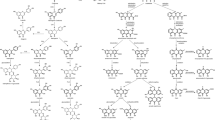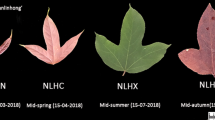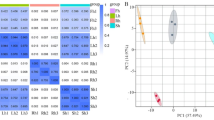Abstract
Introduction
Roses are one of the most essential ornamental flowers and are commonly used in perfumery, cosmetics, and food. They are rich in bioactive compounds, which are of interest for therapeutic effects.
Objectives
The objective of this study was to understand the kinds of changes that occur between the nocturnal and diurnal metabolism of rose and to suggest hypotheses.
Methods
Reversed-phase ultrahigh-performance liquid chromatography coupled with electrospray ionization quadrupole time-of-flight mass spectrometry or triple quadrupole mass spectrometry (TQ MS/MS) was used for nontargeted metabolomics and hormonal profiling respectively. For metabolite annotation, accurate mass spectra were compared with those in databases.
Results
The hormonal profile of flowers showed an increase in jasmonate at night, while that of leaves indicated an increase in the salicylic acid pathway. Nontargeted analyses of the flower revealed a switch in the plant's defense mechanisms from glycosylated metabolites during the day to acid metabolites at night. In leaves, a significant decrease in flavonoids was observed at night in favor of acid metabolism to maintain a level of protection. Moreover, it might be possible to place back some of the annotated molecules on the shikimate pathway.
Conclusion
The influence of day and night on the metabolome of rose flowers and leaves has been clearly demonstrated. The hormonal modulations occurring during the night and at day are consistent with the plant circadian cycle. A proposed management of the sesquiterpenoid and triterpenoid biosynthetic pathway may explain these changes in the flower. In leaves, the metabolic differences may reflect night-time regulation in favor of the salicylic acid pathway.





Similar content being viewed by others
Data availability
The datasets generated and analyzed during the current study are available in the MassIVE repository, https://doi.org/10.25345/C5K931H3
References
Agati, G., Azzarello, E., Pollastri, S., & Tattini, M. (2012). Flavonoids as antioxidants in plants: Location and functional significance. Plant Science. https://doi.org/10.1016/j.plantsci.2012.07.014
Asai, S., & Shirasu, K. (2015). Plant cells under siege: Plant immune system versus pathogen effectorsCurrent Opinion in Plant Biology. https://doi.org/10.1016/j.pbi.2015.08.008
Barupal, D. K., Fiehn, O. (2017). Chemical similarity enrichment analysis (ChemRICH) as alternative to biochemical pathway mapping for metabolomic datasets. Scientific Reports, 7, 14567. https://doi.org/10.1038/s41598-017-15231-w
Batista, A. N. L., Batista, J. M., Souza–Moreira, T. M., Valentini, S. R., Kato, M. J., Zanelli, C. F., & Furlan, M. (2018). Biosynthetic insights into p-hydroxybenzoic acid-derived benzopyrans in piper gaudichaudianum. Journal of the Brazilian Chemical Society, 29(5), 1105–1114. https://doi.org/10.21577/0103-5053.20170238
Bendahmane, M., Dubois, A., Raymond, O., & Bris, M. L. (2013). Genetics and genomics of flower initiation and development in roses. Journal of Experimental Botany. https://doi.org/10.1093/jxb/ers387
Bortolini, D. G., Barros, L., Maciel, G. M., Brugnari, T., Modkovski, T. A., Fachi, M. M., Pontarolo, R., Pinela, J., Ferreira, I. C., & Haminiuk, C. W. I. (2022). Bioactive profile of edible nasturtium and rose flowers during simulated gastrointestinal digestion. Food Chemistry. https://doi.org/10.1016/j.foodchem.2022.132267
Broadhurst, D., Goodacre, R., Reinke, S. N., Kuligowski, J., Wilson, I. D., Lewis, M. R., & Dunn, W. B. (2018). Guidelines and considerations for the use of system suitability and quality control samples in mass spectrometry assays applied in untargeted clinical metabolomic studies. Metabolomics, 14(6), 1–17. https://doi.org/10.1007/s11306-018-1367-3.
Bylka, W., Znajdek-Awizeń, P., Studzińska-Sroka, E., & Brzezińska, M. (2013). Centella asiatica in cosmetology. Postepy Dermatologii i Alergologii, 30(1), 46–49. https://doi.org/10.5114/pdia.2013.33378
Chan-Leon, A., Estrella-Maldonado, H., Dubé, P., Fuentes-Ortiz, G., Moo-Huchin, V. M., Can-Cauich, C., Sauri-Duch, E., Desjardins, Y., & Santamaría, J. M. (2021). Determination of total phenolic contents and antioxidant activities of fruits from wild and creole Carica papaya genotypes in comparison to commercial papaya cultivars. Journal of Food Measurement and Characterization. https://doi.org/10.1007/s11694-021-01121-3
Chen, S. N., Zhang, H. P., Wang, L. Q., Bao, G. H., & Qin, G. W. (2004). Diterpenoids from the flowers of Rhododendron molle. Journal of Natural Products, 67(11), 1903–1906. https://doi.org/10.1021/np040012o
Conart, C., Saclier, N., Foucher, F., Goubert, C., Rius-Bony, A., Paramita, S. N., Moja, S., Thouroude, T., Douady, C., Sun, P., & Nairaud, B. (2022). Duplication and specialization of NUDX1 in rosaceae led to geraniol production in rose petals. Molecular Biology and Evolution, 39(2), 1–20. https://doi.org/10.1093/molbev/msac002
Costa, J. M., Monnet, F., Jannaud, D., Leonhardt, N., Ksas, B., Reiter, I. M., et al. (2015). Open all night long: The dark side of stomatal control. Plant Physiology, 167(2), 289–294. https://doi.org/10.1104/pp.114.253369.
Damtoft, S., Frederiksen, L. B., & Jensen, S. R. (1994). Alatoside and thunaloside, two iridoid glucosides from Thunbergia alata. Phytochemistry, 35(5), 1259–1261. https://doi.org/10.1016/S0031-9422(00)94832-5
Darras, A. (2021). Overview of the dynamic role of specialty cut flowers in the international cut flower market. Horticulturae. https://doi.org/10.3390/horticulturae7030051
de la Rosa, L. A., Moreno-Escamilla, J. O., Rodrigo-García, J., & Alvarez-Parrilla, E. (2018). Phenolic compounds. In E. M. Yahia (Ed.), Postharvest physiology and biochemistry of fruits and vegetables . Elsevier.
Dobler, S., Petschenka, G., & Pankoke, H. (2011). Coping with toxic plant compounds–the insect’s perspective on iridoid glycosides and cardenolides. Phytochemistry. https://doi.org/10.1016/j.phytochem.2011.04.015
Falk, K. L., Kästner, J., Bodenhausen, N., Schramm, K., Paetz, C., Vassão, D. G., et al. (2014). The role of glucosinolates and the jasmonic acid pathway in resistance of Arabidopsis thaliana against molluscan herbivores. Molecular Ecology, 23(5), 1188–1203. https://doi.org/10.1111/mec.12610
González-Coloma, A., López-Balboa, C., Santana, O., Reina, M., & Fraga, B. M. (2011). Triterpene-based plant defenses. Phytochemistry Reviews, 10(2), 245–260. https://doi.org/10.1007/s11101-010-9187-8.
Goodspeed, D., Chehab, E. W., Min-Venditti, A., Braam, J., & Covington, M. F. (2012). Arabidopsis synchronizes jasmonate-mediated defense with insect circadian behavior. Proceedings of the National Academy of Sciences of the United States of America, 109(12), 4674–4677. https://doi.org/10.1073/pnas.1116368109
Graf, A., Schlereth, A., Stitt, M., & Smith, A. M. (2010). Circadian control of carbohydrate availability for growth in Arabidopsis plants at night. Proceedings of the National Academy of Sciences of the United States of America, 107(20), 9458–9463. https://doi.org/10.1073/pnas.0914299107
Huijin, Y., Zhao, Z., Jean-Louis, M., Benoît, B., Sylvie, B., & Kaixue, T. (2020). Virus-induced gene silencing in rose flowers. Methods in Molecular Biology, 2172, 223–232. https://doi.org/10.1007/978-1-0716-0751-0_16
Hvattum, E. (2002). Determination of phenolic compounds in rose hip (Rosa canina) using liquid chromatography coupled to electrospray ionisation tandem mass spectrometry and diode-array detection. Rapid Communications in Mass Spectrometry, 16(7), 655–662. https://doi.org/10.1002/rcm.622
Ilic, J., Cosic, J., Vrandecic, K., Dugalic, K., Pranjic, A., & Martin, J. (2017). Influence of endophytic fungi isolated from symptomless weeds on cherry plants. Mycosphere, 8(1), 18–30. https://doi.org/10.5943/mycosphere/8/1/3.
Jia, Y., Chen, C., Gong, F., Jin, W., Zhang, H., Qu, S., Ma, N., Jiang, Y., Gao, J., & Sun, X. (2022). An Aux/IAA family member, RhIAA14, Involved in ethylene-inhibited petal expansion in rose (Rosa hybrida). Genes. https://doi.org/10.3390/genes13061041
Kanehisa, M., Furumichi, M., Sato, Y., Kawashima, M., & Ishiguro-Watanabe, M. (2023). KEGG for taxonomy-based analysis of pathways and genomes. Nucleic Acids Research, 51(D1), D587–D592. https://doi.org/10.1093/nar/gkac963.
Karapetyan, S., & Dong, X. (2018). Redox and the circadian clock in plant immunity: A balancing act. Free Radical Biology and Medicine. https://doi.org/10.1016/j.freeradbiomed.2017.12.024
Klocke, J. A., Hu, M., Chiu, O., & Kubo, I. (1991). Grayanoid diterpene insect antifeedants and insecticides from Rhododendron molle. Phytochemistry, 30, 1797–1800.
Kunjumon, R., Johnson, A. J., & Baby, S. (2022). Centella asiatica: Secondary metabolites, biological activities and biomass sources. Phytomedicine Plus. https://doi.org/10.1016/j.phyplu.2021.100176
Lefevere, H., Bauters, L., & Gheysen, G. (2020). Salicylic acid biosynthesis in plants. Frontiers in Plant Science. https://doi.org/10.3389/fpls.2020.00338
Liu, Z. H., Liu, H. Y., & Wang, H. Y. (1996). Effect of light on endogenous indole-3-acetic acid, peroxidase and indole-3-acetic acid oxidase in soybean hypocotyls. Botanical Bulletin of Academia Sinica, 37, 113–119.
Magnard, J. L., Roccia, A., Caissard, J. C., Vergne, P., Sun, P., Hecquet, R., et al. (2015). Biosynthesis of monoterpene scent compounds in roses. Science, 349(6243), 81–83. https://doi.org/10.1126/science.aab0696.
Mileva, M., Ilieva, Y., Jovtchev, G., Gateva, S., Zaharieva, M. M., & Georgieva, A. (2021). Rose flowers—a delicate perfume or a natural healer? Biomolecules. https://doi.org/10.3390/biom11010127
Ni, J., Dong, L., Jiang, Z., Yang, X., Chen, Z., Wu, Y., & Xu, M. (2018). Comprehensive transcriptome analysis and flavonoid profiling of Ginkgo leaves reveals flavonoid content alterations in day–night cycles. Plos One, 13(3), 1–17. https://doi.org/10.1371/journal.pone.0193897.
Pieterse, C. M. J., Van Der Does, D., Zamioudis, C., Leon-Reyes, A., & Van Wees, S. C. M. (2012). Hormonal modulation of plant immunity. Annual Review of Cell and Developmental Biology, 28, 489–521. https://doi.org/10.1146/annurev-cellbio-092910-154055.
Pires, T. C. S. P., Barros, L., Santos-Buelga, C., & Ferreira, I. C. F. R. (2019). Edible flowers: Emerging components in the diet. Trends in Food Science and Technology. https://doi.org/10.1016/j.tifs.2019.09.020
Rao, A. S. (2017). Isolation, absolute configurationand bioactivities of megastigmanes or C13 isonorterpinoides. Chemistry International, 3(1), 69–91.
Raymond, O., Gouzy, J., Just, J., Badouin, H., Verdenaud, M., Lemainque, A., et al. (2018). The rosa genome provides new insights into the domestication of modern roses. Nature Genetics, 50(6), 772–777. https://doi.org/10.1038/s41588-018-0110-3
Saint-Oyant, L. H., Ruttink, T., Hamama, L., Kirov, I., Lakhwani, D., Zhou, N. N., et al. (2018). A high-quality genome sequence of Rosa chinensis to elucidate ornamental traits. Nature Plants, 4(7), 473–484. https://doi.org/10.1038/s41477-018-0166-1
Scalliet, G., Journot, N., Jullien, F., Baudino, S., Magnard, J. L., Channeliére, S., et al. (2002). Biosynthesis of the major scent components 3,5-dimethoxytoluene and 1,3,5-trimethoxybenzene by novel rose O-methyltransferases. FEBS Letters, 523(1–3), 113–118. https://doi.org/10.1016/S0014-5793(02)02956-3.
Schymanski, E. L., Jeon, J., Gulde, R., Fenner, K., Ruff, M., Singer, H. P., & Hollender, J. (2014). Identifying small molecules via high resolution mass spectrometry: Communicating confidence. Environmental Science and Technology. https://doi.org/10.1021/es5002105
Sood, S., Vyas, D., & Nagar, P. K. (2006). Physiological and biochemical studies during flower development in two rose species. Scientia Horticulturae, 108(4), 390–396. https://doi.org/10.1016/j.scienta.2006.02.012.
Süntar, I., Nabavi, S. M., Barreca, D., Fischer, N., & Efferth, T. (2018). Pharmacological and chemical features of Nepeta L. genus: Its importance as a therapeutic agent. Phytotherapy Research. https://doi.org/10.1002/ptr.5946
Takahashi, J. A., Rezende, F. A. G. G., Moura, M. A. F., Dominguete, L. C. B., & Sande, D. (2020). Edible flowers: Bioactive profile and its potential to be used in food development. Food Research International. https://doi.org/10.1016/j.foodres.2019.108868
Tungmunnithum, D., Kongsawadworakul, P., & Hano, C. (2021). A cosmetic perspective on the antioxidant flavonoids from nymphaea lotus l. Cosmetics, 8(1), 1–9. https://doi.org/10.3390/cosmetics8010012.
Villette, C., Zumsteg, J., Schaller, H., & Heintz, D. (2018). Non-targeted metabolic profiling of BW312 Hordeum vulgare semi dwarf mutant using UHPLC coupled to QTOF high resolution mass spectrometry. Scientific Reports. https://doi.org/10.1038/s41598-018-31593-1
Wasternack, C., & Hause, B. (2013). Jasmonates: Biosynthesis, perception, signal transduction and action in plant stress response, growth and development. An update to the 2007 review in annals of botany. Annals of Botany. https://doi.org/10.1093/aob/mct067
Weinhold, A., Shaker, K., Wenzler, M., Schneider, B., & Baldwin, I. T. (2011). Phaseoloidin, a homogentisic acid glucoside from nicotiana attenuata trichomes, contributes to the plant’s resistance against lepidopteran herbivores. Journal of Chemical Ecology, 37(10), 1091–1098. https://doi.org/10.1007/s10886-011-0012-7
Xiao, Z., Li, J., Niu, Y., Liu, Q., & Liu, J. (2017). Verification of key odorants in rose oil by gas chromatography–olfactometry/aroma extract dilution analysis, odour activity value and aroma recombination. Natural Product Research, 31(19), 2294–2302. https://doi.org/10.1080/14786419.2017.1303693
Yasui, H. (2001). Sequestration of host plant-derived compounds by geometrid moth, milionia basalis, toxic to a predatory stink bug, Eocanthecona furcellata. Journal of Chemical Ecology, 27, 1345–1353.
Yoshikawa, M., Nakamura, S., Li, X., & Matsuda, H. (2008). reinvestigation of absolute stereostructure of ()-rosiridol: structures of monoterpene glycosides, rosiridin, rosiridosides A, B, and C from Rhodiola sachalinensis 1) chart 1. Chemical & Pharmaceutical Bulletin, 56, 695–700.
Yuan, Z., & Zhang, D. (2015). Roles of jasmonate signalling in plant inflorescence and flower development. Current Opinion in Plant Biology. https://doi.org/10.1016/j.pbi.2015.05.024
Zhang, C., Lei, Y., Lu, W., & Wu, J. (2019). MYC2 MYC3 and MYC4 function additively in wounding-induced jasmonic acid biosynthesis and.pdf. Journal of Integrative Plant Biology. https://doi.org/10.1111/jipb.12902
Author information
Authors and Affiliations
Contributions
DH conceived and designed the research. JZ, CV, LG and EB conducted experiments. LG and EB provided raw material. JZ performed statistical analysis. JZ and CV analyzed data. JZ wrote the manuscript. All authors edited and approved the manuscript
Corresponding author
Ethics declarations
Competing interest
The authors have no competing interests to declare that are relevant to the content of this article.
Ethical approval
This article does not contain any studies with human and/or animal participants performed by any of the authors.
Additional information
Publisher’s Note
Springer Nature remains neutral with regard to jurisdictional claims in published maps and institutional affiliations.
Supplementary Information
Below is the link to the electronic supplementary material.
Rights and permissions
Springer Nature or its licensor (e.g. a society or other partner) holds exclusive rights to this article under a publishing agreement with the author(s) or other rightsholder(s); author self-archiving of the accepted manuscript version of this article is solely governed by the terms of such publishing agreement and applicable law.
About this article
Cite this article
Zumsteg, J., Bossard, E., Gourguillon, L. et al. Comparison of nocturnal and diurnal metabolomes of rose flowers and leaves. Metabolomics 20, 4 (2024). https://doi.org/10.1007/s11306-023-02063-1
Received:
Accepted:
Published:
DOI: https://doi.org/10.1007/s11306-023-02063-1




